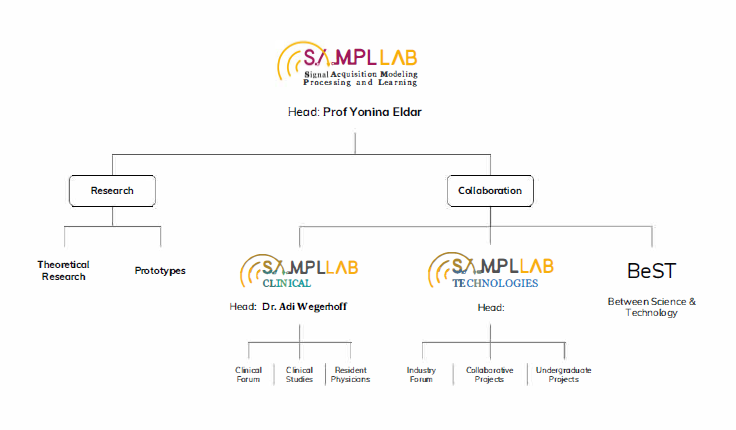Pushing the Frontiers of Signal Processing to Advance Human Lives & Wellbeing
The Signal Acquisition Modeling Processing and Learning (SAMPL) Lab, headed by Prof. Yonina Eldar, focuses on developing new technologies that more efficiently extract and process signals and information across a wide range of tasks, including medical imaging, radar, communication, scientific and optical imaging and biological inference. The lab also develops model-based methods for artificial intelligence (AI) that aid in obtaining increased information using minimal resources.
Signal processing is the area of science and engineering concerned with the generation, acquisition, representation, transmission and analysis of signals and information using mathematical theory and methods. Signal processing is the power behind our modern lives, enhancing our ability to communicate and share information. The technology in our everyday lives – from computers, cell phones and autonomous vehicles to medical and defense systems – is enabled by signal processing. The performance and effectiveness of these systems depend on the quality and efficiency of signal sampling and processing. In many cases, such as medical applications, automotive and aviation, these capabilities are critical to human health, life and wellbeing.
In the coming years, new and increasingly complex challenges will arise as we become even more dependent on signal processing in our everyday lives. As countless additional tasks and functions are replaced by smart and automated applications, they will require increasingly faster and more powerful technologies. As these new technologies sweep across the planet to billions of people in emerging markets, they will need to become increasingly more efficient and less costly.
While traditional systems treat the sampling and processing stages separately and require sampling at the well-known Nyquist rate, SAMPL lab introduces a paradigm shift in which sampling and processing are jointly designed in order to leverage the inherent properties of signals and tasks during the sampling stage. Thus, we can acquire and process only the information needed for the required task, reduce the sampling and processing rates well below the Nyquist rate, and greatly improve the resolution which can be obtained from a limited number of samples in time, space and frequency.
This approach paves the way to new technologies such as wireless ultrasound, compact portable devices with better imaging quality, fast and quantitative MRI, efficient wideband sensing, high resolution radar, efficient communication systems, joint radar and communication systems for automotive and IoT applications, super resolution microscopy and ultrasound, model-based efficient and interpretable deep networks for medical imaging, communication systems, radar based medical imaging and sensing, and more.
In order to perform the above, SAMPL lab combines theoretical research in the fields of mathematics, information theory, statistical signal processing, AI and computer science, and practical engineering research using our state-of-the-art lab to facilitate the transition from pure theory to prototype systems and clinical studies. Via our Clinical Research arm, we collaborate with physicians across Israel and abroad, to advance healthcare, medical diagnostics and imaging. Via our Technologies arm, we collaborate with industry partners to impact next-generation technologies. In addition, we collaborate closely with researchers in biology and physics in order to advance technology for scientific discovery.


Our Mission
Pushing the Frontiers of Signal-Processing and Machine Learning to Improve the Performance and Effectiveness of Today's Technologies
Revolutionizing Signal Acquisition and Processing
SAMPL lab introduces a paradigm shift in signal sampling and processing, enabling the reduction of sampling, quantization and processing rates well below the Nyquist rate. By enabling the extraction of more information using fewer resources we can make machines think faster, make devices smaller and less costly and enhance their quality, helping doctors diagnose better, enabling more people around the world access to better services, and providing more powerful tools to enable scientific discoveries.
Between Theory and Applications
We facilitate the transition from pure theoretical research to the development, design, and implementation of prototype systems and clinical studies. We believe that theory and practice, when intertwined, help advance scientific discovery and human needs.
Impact
We strive to harness our technologies to impact medicine, technology and basic science, and to drive progress for the benefit of society and human welfare:
- Impacting Medicine – We aim to improve medical diagnosis, working in close collaboration with physicians and engaging in clinical studies. We wish to enhance early detection of diseases, reduce diagnostic errors, support physicians in their decision-making, and develop more accessible and higher quality medical devices. In addition, we strive to use innovative technologies, such as radar, for contactless patient diagnosis and monitoring.
- Impacting Industry – We work with our industry partners to impact next-generation technologies, such as more efficient communication systems, high-resolution radar, joint radar and communication systems for automotive and IoT applications, and more.
- Impacting Science – Providing more powerful and higher-quality tools to enable scientific discoveries, e.g., super resolution microscopy and live cell imaging, and providing advanced AI and signal processing tools for biological and physical inference.
Inter-disciplinary Research
By fostering and promoting collaborations among researchers from diverse disciplines, we hope to promote diversity of thought and advance cutting-edge theoretical research and breakthroughs, and enrich various application domains by guiding scientific discovery toward real-world needs.
Education
We provide tools and methodologies for excellence in scientific research by teaching and mentoring of students, post-docs and resident physicians at their basic science research, with the purpose of shaping a future generation of researchers who will be as passionate as we are for cutting-edge scientific research that impacts society.




